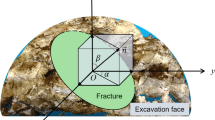Summary
The feasibility and safety of a mining project or the choice among alternative mining methods could depend on the joint densities and orientations within the rock mass. The accurate determination of the orientation of all joints is technically difficult and often economically unrealistic. This study presents a new approach in classifying joints found in exploration boreholes as joint sets, whose statistical distribution is determined from a few hundred oriented joints in boreholes. Each non-oriented joint is classified as belonging to a set based on its “a posteriori” probability of membership in a Bayesian framework. The theoretical rate of success of the classification can be computed for each possible borehole orientation and plotted on a stereonet to determine the optimal orientation of new boreholes. The performance and limitations of this approach are investigated. An application example at the Mont Porphyre's large scale block-caving project at Gaspé Mines, Quebec, Canada, is studied.
Similar content being viewed by others
Author information
Authors and Affiliations
Rights and permissions
About this article
Cite this article
Henry, E., Marcotte, D. & Kavanagh, P. Classification of Non-oriented Fractures Along Boreholes to Joint Sets and its Success Degree. Rock Mech Rock Engng 34, 257–273 (2001). https://doi.org/10.1007/s006030170001
Issue Date:
DOI: https://doi.org/10.1007/s006030170001




